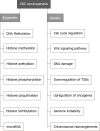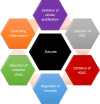Colorectal cancer: The epigenetic role of microbiome
- PMID: 31799293
- PMCID: PMC6887622
- DOI: 10.12998/wjcc.v7.i22.3683
Colorectal cancer: The epigenetic role of microbiome
Abstract
Colorectal cancer (CRC) is the third most common cancer in men (746000 cases per year) and the second most common cancer in women globally (614000 cases per year). The incidence rate of CRC in developed countries (737000 cases per year) is higher than that in less developed countries (624000 cases per year). CRC can arise from genetic causes such as chromosomal instability and microsatellite instability. Several etiologic factors underlie CRC including age, diet, and lifestyle. Gut microbiota represent a proven cause of the disease, where they play pivotal roles in modulating and reshaping the host epigenome. Several active microbial metabolites have been found to drive carcinogenesis, invasion, and metastasis via modifying both the methylation landscape along with histone structure in intestinal cells. Gut microbiota, in response to diet, can exert both beneficial and harmful functions in humans, according to the intestinal balance of number and types of these bacteria. Although the intestinal microbial community is diverse among individuals, these microbes cumulatively produce 100-fold more proteins than the human genome itself, which calls for further studies to elaborate on the complicated interaction between these microorganisms and intestinal cells. Therefore, understanding the exact role that gut microbiota play in inducing CRC will help attain reliable strategies to precisely diagnose and treat this fatal disease.
Keywords: Cancer; Colorectal; Colorectal cancer; Epigenetics; Gut; Microbiota.
©The Author(s) 2019. Published by Baishideng Publishing Group Inc. All rights reserved.
Conflict of interest statement
Conflict-of-interest statement: The authors declare no conflicts of interest.
Figures




References
-
- Kalady MF, Boland CR, Church JM. Philadelphia: Content Repository Only; 2019. Chapter 165 - Inherited Colorectal Cancer and the Genetics of Colorectal Cancer. In: Yeo CJ. Shackelford's Surgery of the Alimentary Tract, 2 Volume Set (Eighth Edition) pp. 1959–1980.
-
- Baretti M, Azad NS. The role of epigenetic therapies in colorectal cancer. Curr Probl Cancer. 2018;42:530–547. - PubMed
-
- Lei Z, Ma X, Li H, Zhang Y, Gao Y, Fan Y, Li X, Chen L, Xie Y, Chen J, Wu S, Tang L, Zhang X. Up-regulation of miR-181a in clear cell renal cell carcinoma is associated with lower KLF6 expression, enhanced cell proliferation, accelerated cell cycle transition, and diminished apoptosis. Urol Oncol. 2018;36:93.e23–93.e37. - PubMed
-
- Serino M. Molecular Paths Linking Metabolic Diseases, Gut Microbiota Dysbiosis and Enterobacteria Infections. J Mol Biol. 2018;430:581–590. - PubMed
Publication types
LinkOut - more resources
Full Text Sources

